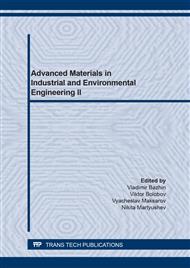p.28
p.35
p.41
p.47
p.55
p.61
p.68
p.75
p.87
Solvothermal Synthesis of YF3:Ce3+ Nanophosphors for Medical Applications
Abstract:
In this paper, the time effect of hydrothermal synthesis on YF3 morphology particles is considered. The work was carried out on X-ray-excited YF3:Ce3+ phosphors. The synthesis was carried out by the hydrothermal method, since it avoids high temperatures leading to particle agglomeration. The first stage of research consisted in identifying the most favorable medium for obtaining the required phase and size - water or organic matter (ethylene glycol and ethanol). Research has shown that ethylene glycol has all the advantages: it prevents agglomeration, allows us to get the required phase. Hydrothermal synthesis of YF3 samples to determine the optimal synthesis time was carried out according to the same scheme - in an organic medium of ethylene glycol without using stabilizers for 4, 8, 12, 16, 20 hours. Our study showed that it is possible to obtain a YF3 sample that meets the necessary requirements (including nanoscale) within 16 hours, moreover, without the use of stabilizers. In parallel with the study of the synthesis duration, an experiment was carried out on the effect of various stabilizers on the properties of the YF3:Ce3+ phosphors (5%). The synthesized nanophosphors possessed effective X-ray luminescence with a maximum in the region of 300 nm, which makes it possible to use them in the composition of preparations for PDT.
Info:
Periodical:
Pages:
55-60
Citation:
Online since:
July 2021
Price:
Сopyright:
© 2021 Trans Tech Publications Ltd. All Rights Reserved
Share:
Citation:


